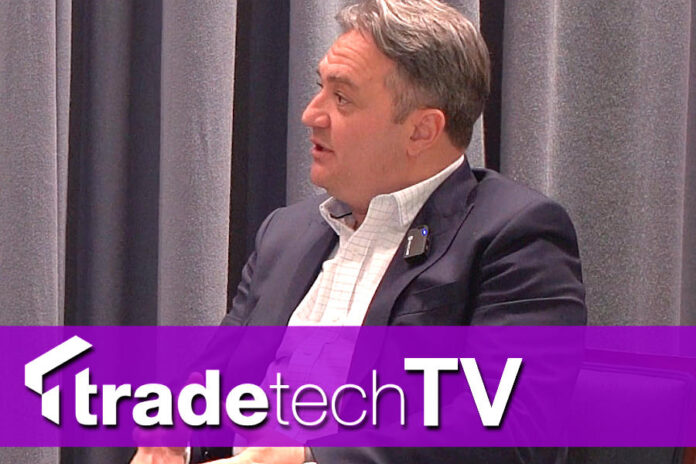Anton Panayotov, CEO of Alaric Securities, discusses the unique role of the retail broker (halfway between buy and sell-side), why the move to multi-asset brings it’s own substantial challenges of scale, and the compelling reasons behind his decision to outsource his trading function.
Accessing liquidity electronically in fragmented markets
A Q&A with Eric Stockland, MD, Co-Head of Global Electronic Trading and Michael Green, MD, COO of European Electronic Trading, BMO Capital Markets
Throughout global equity markets, there seems to be commonalities across regions. They are continually becoming more complex, they are becoming more fragmented, and they are becoming more electronic. According to a Coalition Greenwich research report The Globalization of Algorithmic Equity Trading: A Buy-Side View, electronic trading has grown to 42% of US and 44% of the European equity market commissions. In three years, managers expect this to grow to 48% and 50%, respectively.
Market innovations have driven regulators to try and keep up with the speed of innovation, while trying to maintain the delicate balance between the advancements in technology to facilitate more efficient trading alongside the fair and equitable access to capital markets and price discovery amongst all market participants.
At the heart of this innovation, is access to liquidity and having the ability to aggregate that liquidity to make the most informed trading decisions to yield best execution for your clients.
We had the opportunity to speak with Eric Stockland, MD, Co-Head of Global Electronic Trading and Michael Green, MD, COO of European Electronic Trading, both of BMO Capital Markets, to discuss the global challenges of effectively aggregating liquidity, with the more nuanced complexity as it applies to European markets.
Eric, what are the biggest challenges you see in the fragmentation of the markets you serve and how are you overcoming those challenges?

We service institutions in the US, Canada, and EMEA. We provide them with a suite of algorithms designed to leverage the regional market microstructure to trade with the least amount of impact, but in the most efficient and opportunistic way to achieve our clients desired outcomes.
In Canada, the issue of fragmentation is less complex than it is in the US and Europe. In the US, we have roughly 16 exchanges and 54 off-exchange venues we access. Having connectivity to these venues are table-stakes for anyone in this business, but the true level of value you can provide to your clients is not in the access, but it’s in how, when, and why you would choose to route to one venue over another, and during which phases of the algos aggression.
We call that, “Trading Where You Have Edge”. That edge comes from having people who deeply understand the regional market microstructure, who embody a performance-driven experimentation mindset, and who can construct algorithms that are explicitly designed to respond to the nuances of the market. By continuously making small improvements to an algo’s behaviour, we can consistently, with empirical evidence improve an algo’s performance.
We also use this “Edge” to lean into the introduction of new venues and to test their performance. As an electronic partner to our clients, it is our responsibility to present the unique liquidity profiles of new venues and to determine a systematic way to explore this new liquidity with minimal impact, while controlling for opportunity costs to determine if they indeed earn a spot within our routing protocol.
This is how we proactively manage fragmentation, and how we have successfully helped our clients explore new liquidity and improve their electronic performance. We are excited to take these learnings and apply them where applicable in EMEA.
Mike, Eric gave us an overview of BMO’s approach to venue fragmentation, how do you intend to apply it in EMEA?

The keyword Eric used is “proactive”, the one constant in our equity markets is innovation and as I see it, there are no signs of it slowing down. The fact is, we embrace innovation, and we have the benefit of transferring the knowledge obtained from our partners in North America to EMEA. It is what differentiates us from all the others.
Beyond the on and off-exchange fragmentation of markets, we must also contend with the implications of Brexit. Which essentially doubled the venues we need to access, exacerbating the issue of fragmentation in EMEA.
While it may seem like a daunting liquidity landscape, at BMO we not only have the technology to access these venues and the algo infrastructure to achieve our best execution obligations. We have the people who partner with our clients, examining the market microstructure, collaborating to build and optimise algos, with the goal of maximising our client’s performance outcomes.
On behalf of our clients, we must effectively navigate the European market structure at a time when volumes are moving off lit exchanges, to SIs, periodic auctions, MTFs, conditionals, and dark pools. In addition to the transition from intra-day trading to more significant volumes trading at the end of the day.
In Europe, we employ the same performance-based mindset. We constantly factor in our decisions to route, a venues quality of execution and potential for information leakage. Within our algo framework, we can choose when to trade passively, aggressively, or opportunistically. We can proactively manage within the upper and lower bounds of the trading schedule the child order slices behaviour as it relates to where we are within the schedule.
The way in which we manage the schedule, construct algo design, interpret the market microstructure, execute and analyse performance are the unique value-adds we give our clients.
We as an agency broker-dealer, are not contributing to the fragmentation. We don’t have an internal risk book and we don’t operate an SI. We provide unbiased routing protocols, driven by performance. As new venues enter the marketplace in Europe, they too will have to earn their spots in our routing protocols.
Looking ahead
As it seems innovation is here to stay, and whether fragmentation is viewed as good, bad or indifferent, brokers are going to have to figure out a way to evaluate venues and provide access and intelligence to their buy-side clients. We will continue to watch this space as European-based venues continue to innovate, and even as US-based companies, like OptimX, OneChronos, and Intelligent Cross prepare to engage in European markets.
*Market Viewpoints comprise sponsored content and do not necessarily reflect the views of the editor.
©Markets Media Europe 2024 TOP OF PAGELiquidnet expands equities services offering
Liquidnet has expanded its equities workflows and services offering with SuperBlock, a suite it states will provide simpler participation in exceptionally large or illiquid block trades.
Minimum trade sizes will differ by each stock’s market capitalisation, Liquidnet explained, with a focus on the most difficult executions and orders.
SuperBlock Matching is the first release from the initiative, a platform providing users with a different way to match with each other and granting further control over the execution of difficult blocks, the company said.
Speaking to Global Trading, Rob Cranston, global head of equities product at Liquidnet, elaborated on the future of SuperBlock. “We want to look at how we can talk to our members and find opportunities for members to move difficult positions,” he explained. “What’s next is getting this live, having a lot of conversations, getting feedback from members and finding out how they want to move forward, and then planning the next steps.”
Mark Govoni, Liquidnet CEO, said: “The creation of a protected space to trade the most challenging blocks is a direct response to a request from our membership and is an extension of our existing block trading offering, to facilitate more complex and nuanced trades.”
Cranston expanded on the initiative’s origins: “We run a series of innovation sessions every year with our members, called Liquidnet Labs,” he explained. “Last year, one of the topics we focused on was super block trading. Members wanted some help and innovation on how they trade very large or difficult positions into the marketplace.”
“It’s a commitment from us that we’re going to continue to focus on this segment of the market where there hasn’t been a lot of innovation in the last few years,” he concluded.
©Markets Media Europe 2024
Imandra launches AI FIX connectivity tool
AI firm Imandra has launched FIX Wizard, an AI assistant for its FIX Connectivity suite.
The service creates a full logical model – a ‘digital twin’ – of an API for FIX connectivity. Using this gateway, statistical AI and Imandra’s neuro-symbolic architecture, FIX Wizard can then answer questions on the FIX specification and rules of engagement.
Customer-provided FIX traffic can be analysed, with underlying causes of issues are identified and recommendations made on how to address them. Multiple issues can be diagnosed at once, the company added, rather than just the first problem encountered.
Guidance is also provided on certification test cases, and conformance tests are run against the implementation.
Verifiable audit trails are provided in line with regulatory requirements.
With this approach, Imandra said, the product addresses the shortcomings of large language models in regulated markets such as hallucinations, lack of scalability to unseen inputs, and a lack of validation of knowledge sources.
Grant Passmore, co-CEO of Imandra, said: “Large language models (LLMs) hold tremendous promise, but ultimately cannot be trusted in regulated environments. By combining their strengths with scalable, rigorous automated reasoning, we obtain a kind of magic: conversational interfaces with correct reasoning and domain-specific skills.”
©Markets Media Europe 2024
Appital launches opportunistic liquidity functionality
Peer-to-peer price discovery and liquidity sourcing technology provider Appital has launched Trending Equities, designed to drive opportunistic liquidity.
Trending Equities enables proactive stimulation of unique market liquidity from buy-side deal originators, in advance of a deal launch. Buy-side firms are also able to gain exposure to potential imminent deal launches on the platform in equities relevant to them.
Mark Badyra, CEO of Appital, told Global Trading: “Access to hard-to-find liquidity remains a huge challenge for the buy side and matching technology alone is not enough to help unlock latent liquidity.
“Historically, the market for size has been driven by brokers but concerns over information security and leakage have further contributed to a decline in liquidity. Matching technology is not up to the task as the likelihood of a match naturally decreases with order size. At the same time, the most challenging trades require greater control and oversight by buy-side traders and we see large/parent orders being cut down to manage information leakage, thereby exacerbating systemic illiquidity in the market. With Appital Trending Equities we move closer to solving this problem by proactively stimulating market liquidity ahead of the event.”
Unlocking latent liquidity though this service allows trading desks and portfolio managers to generate orders on the market that would not otherwise exist, Appital explained, enabling greater optionality, and driving the bookbuilding process. Matching technology alone is not enough to achieve this, Mark Badyra, CEO of Appital, explained to Global Trading.
“Historically, the market for size has been driven by brokers but concerns over information security and leakage have further contributed to a decline in liquidity,” he continued. “Matching technology is not up to the task as the likelihood of a match naturally decreases with order size. At the same time, the most challenging trades require greater control and oversight by buy-side traders and we see large/parent orders being cut down to manage information leakage, thereby exacerbating systemic illiquidity in the market. With Appital Trending Equities we move closer to solving this problem by proactively stimulating market liquidity ahead of the event.”
It also solves challenges around decreasing lit liquidity, the company affirms, reducing reliance on market close and addressing the reduction in high-touch sales trading and its associated liquidity opportunities.
The functionality sits within Appital Insights, a service allowing buy-side institutions to gain feedback on the likelihood of launching a successful bookbuild without alerting others in the market or risking price erosion. It also allows traders and portfolio managers to gain passive exposure in equities, the company stated, with consideration to minimum average daily volume ambitions and pricing thresholds.
Trending Equities is now in use by Appital’s onboarded asset managers.
©Markets Media Europe 2024
FABIEN OREVE on how to tackle European equities market fragmentation

Candriam’s deputy global head of trading and head of equity trading discusses the challenges facing the European equity markets today – from portfolio trading and venue selection to T+1 and post-trade automation.
How are you handling the current market fragmentation for European equities?
I think it’s important to use a decent range of equity brokers and trading protocols to access diverse pools of liquidity in Europe. For European equities, transaction size and liquidity have decreased on the continuous markets of traditional exchanges over recent years, making the execution of large tickets challenging.
As such, it is essential to have a high level of flexibility and agility for the execution of large tickets in European equities, using both low-touch and high-touch connections to traditional brokers, technology-driven brokers and electronic market-makers; including derivatives specialists who provide an additional source of block crossing opportunities in cash equity markets.
This flexibility for order execution is even more necessary as liquidity has never been so dispersed across EU execution venues. On the one hand, market fragmentation has brought some benefits such as increased competition between venues and reduced brokerage commissions for investors, while on the other, it has made the EU liquidity landscape more complex.
In certain situations, portfolio trading can mitigate the challenges posed by liquidity fragmentation, like the risk of market impact or ‘slippage’ from an execution reference. For lists of buy and sell orders concentrated on a thematic area, portfolio trading sometimes offers opportunities for ‘natural hedges’. As an illustration, if a basket includes buy orders for liquid stocks in sector A and sell orders for liquid stocks with a similar beta in sector B, working these orders simultaneously can help minimise execution ‘slippage’ at the basket level.
How has portfolio trading evolved in an equity market structure which faces the fragmentation of execution venues in Europe?
For a long time, activities such as starting new portfolios, transitioning existing portfolios, or simply subscribing and redeeming fund shares, required the use of portfolio trades, with closing prices as the execution reference. With new technological developments, portfolio trading (PT) has become more sophisticated, supporting the growth of quantitative investment strategies, whether it involves market-neutral strategies (e.g. using derivatives like futures) or other quantitative approaches.
Over the past 15 years, the proliferation of trading venues in equities has accelerated the development of agency trading and sophisticated algorithms, particularly those dedicated to PT. The adoption of PT, then, expanded widely into other types of equities investment strategies, each with different objectives.
In recent years, it has been interesting to note that some thematic investment strategies, traditionally focused on stock picking, have been increasingly turning to PT for order execution, mixing low-touch techniques (volume-weighted average price (VWAP) or implementation shortfall (IS) algorithms) with a high-touch approach to trading blocks. Combining low-touch with high-touch solutions for PT looks a bit like a car assembly line, with both automated and manual elements that need constant adjustment based on volume.
In the case of a complex basket with ‘illiquid stocks’ orders showing a high percentage of average daily volume (ADV), the flexibility of PT also allows the exclusion of those illiquid stocks from the list to homogenise the basket and achieve the best execution for all orders. Before execution, it is sometimes necessary to determine what will be executed outside the basket (individual orders traded against indications of interests), and what will be executed inside a ‘reformatted’ basket.
What are your top trading trends for 2024?
In recent months, higher volatility following European companies’ results has been increasingly challenging for equity trading desks, and in 2024, traders will continue to find ways to navigate these particular situations. Most traders will also continue to operate in an increasingly technological environment, where high-touch trading is no longer considered as old-fashioned and is being reformatted to a more hybrid method of execution.
Liquidity in European equities will not be the only big theme in 2024.The US move to T+1 settlement will also be a great point of focus [this quarter] as this change is just around the corner (end of May). Due to stringent cut-off time for booking and settlement in the US, European asset managers will have to implement some form of automation in post-trade between their order management system (OMS), their middle-office’s trade validation system and custodian banks. The introduction of T+1 in the US will likely trigger a complete review of operational efficiency among asset managers, and require closer collaboration between them, their brokers and their custodians to ensure a seamless transition to this new regime.
©Markets Media Europe 2024
Savings and investments union would strengthen EU competitiveness
Establishing a savings and investments union will unlock €33 trillion in private savings, according to former Italian prime minister Enrico Letta, boosting EU competitiveness on the global stage.
In his recent report, Letta stated that establishing a savings and investments union within the EU single market will help to build a more integrated and robust European financial market, allowing the region to channel its savings towards investment needs.
Currently, per the report, a significant proportion of the €33 trillion in private savings across the EU is being diverted to the US economy and US asset managers. “This phenomenon underscores a significant inefficiency in the utilisation of the EU savings,” Letta affirmed, savings which could otherwise be used to help the EU achieve its strategic directives.
By introducing a savings and investments union, these savings could be retained in the EU and encourage greater investment in the continent, both from domestic and private investors. “This strategic approach is vital for enhancing the EU’s financial landscape,” he said, “ensuring that it can harness its substantial economic resources to their fullest potential, thereby supporting its role as a key player on the global stage.”
Elsewhere in his report, Letta highlighted the factors driving the need for updates to the European single market. These include a demographic and economic shift since the single market was established. Europe faces an ageing and shrinking population, Letta explains, and is lagging behind both the US and Asia. The EU needs to become more competitive on a global scale, he adds, advocating for the mobilisation of private capital and a conclusion on the state aid debate.
In addition, the “rules-based international order” that the single market is based around is facing a number of challenges; trade conflicts, wars and the “resurgence of power politics” are undermining the system’s principles. Letta goes on to state that the success of the EU relies on free trade and openness and that as such, an international framework needs to focus on upholding this order and maintaining peace and economic security. “It must be able to protect the fundamental freedoms, based on a level playing field, while supporting the objective of establishing a dynamic and effective European industrial policy”.
Letta presents the upcoming Multiannual Financial Framework (2024-2029) as fertile ground for such changes to be made, advancing the vision of an updated single market.
The European Fund and Asset Management Association (EFAMA) has voiced its broad agreement with the principles of Letta’s report, commenting that “While we will need some time to analyse Enrico Letta’s report, we welcome its high level of ambition and the determination to make a leap, cut red tape, strengthen the single market and allow EU companies to compete on a global level. More competitive European companies will naturally attract more capital and enjoy better financing conditions, thereby further reinforcing their competitiveness.
“Letta correctly identifies that when it comes to boosting EU capital markets, better connecting the real economy with European citizens’ savings will be a key driver of success. We now need bold actions from all stakeholders involved to turn that vision into reality.”
©Markets Media Europe 2024
LSEG argues against including pre-trade data in a UK consolidated tape
The London Stock Exchange Group has finally come out with a stance on the consolidated tape, an issue on which it has hitherto remained cautious. A new statement released today by head of market structure Jessica Morrison urges an “accurate post-trade tape” but says that “a robust use case” for including pre-trade data is lacking.

The growth of the UK capital markets should be a priority, says Morrison, noting that “market data improvements should be prioritised against the backdrop of the broader regulatory agenda” and that consideration must be given to the UK’s unique market structure compared to the US and Europe, including its retail market and the “outsized proportion” of SI volumes, driven in part by the distortions caused by the UK stamp tax regime.
READ MORE: Where next? The future for a consolidated tape in Europe
An accurate UK post-trade tape, says Morrison, would enable the buy-side to place larger orders and the sell-side to include the additional available liquidity in volume profiles, moving away from the current venue-only calculations. LSEG also recommends that the UK’s Financial Conduct Authority (FCA) initiate a review of post-trade reporting accuracy, as “transparency of volumes is essential for the market”.
No need for pre-trade
The report goes on to make an argument against the (initial) inclusion of pre-trade data into any UK equities tape. “Feedback from the market is that having agreed volume numbers both in terms of addressable and total liquidity would be most effective in improving secondary market trading liquidity,” explains Morrison. “We would not want the FCA to delay the roll out of a post-trade tape while there is a necessary debate around the value of and risks associated with a pre-trade tape.”
LSEG believes that the quantity and quality of secondary market liquidity is central to retaining listings and stemming the tide of liquidity out of the UK. “The ability to inform current issuers about total activity in their company and prospective issuers about total liquidity in their peer companies… is integral to the attractiveness of London as a destination for IPOs and secondary trading,” urges the report.
READ MORE: FCA mulls inclusion of pre-trade data in equities consolidated tape plans
Best execution concerns
In addition, claims Morrison, “a robust case for a real time pre-trade tape is lacking”. Although pre-trade data has benefits when it comes to TCA and historical order placement analysis, LSEG does not believe that this information is used often enough, on a trade-by-trade basis, to make it worth including. Instead, it recommends, users should utilise vendors who already provide this data on an aggregated post-trade basis.
With UK lit continuous volumes at all-time lows, LSEG also believes that further quantitative metrics need to be analysed to consider the impact on price formation. “If price formation breaks down, it is to the detriment of all mechanisms that use lit order book liquidity as a reference price,” stresses the report.
LSEG warns that when it comes to pre-trade data, latency should be a key concern that could negatively influence quality of execution. “Using a delayed market data feed for trading would result in uncertainty in execution outcome and so complicates the ability to demonstrate best execution,” it says.
Keep it simple: stick to post-trade
LSEG’s position is that an accurate post-trade tape could provide the price, volume and venue information needed for a trader to get a more complete view of the market given the inclusion of trades executed away from central limit orderbooks (CLOBs).
“Members of the London Stock Exchange have indicated that they will continue to trade on
direct feeds as they value precision of execution. Others using pre-trade market data for automated trading should consider the value of a pre-trade CT given the impact on execution quality and certainty,” stressed the report. “If the sell-side stay on direct feeds but the buy-side move to stale consolidated feeds for automated order placement, we believe this may lead to a mismatch in expected execution outcomes.”
READ MORE: FIX EMEA – UK enters challenging phase in commercial appointment for consolidated tape
Cost v quality
Finally, Morrison warns achieving a robust tape will require robust investment – and a pre-trade tape could be prohibitively expensive, as well as overtly risky.
“Producing a low latency, operationally resilient pre-trade feed simply cannot be achieved on a low-cost basis without compromising quality. Whilst we agree that there is a need for better market transparency, we do not see how a pre-trade CT can act as a tradable back-up in case of a lit market outage and not be subject to the same operational risk measures as venues.”
Market opposition

The statement, and its strong position against the inclusion of pre-trade data, is in direct contrast to the position of some other stakeholders – notably Cboe, whose president of North American and European equities, Natan Tiefenbrun, has been vocal in his support for pre-trade information.
“The paper makes some valid points on market transparency and the importance of getting the post trade tape right,” Tiefenbrun told Global Trading. “But the benefits of a pre-trade tape are widely understood and supported by the majority of data users, so it is disappointing that this doesn’t have the LSE’s support and that they use arguments to support their position that have been widely debunked. We’ll continue to advocate for a real-time pre- and post-trade CT in the UK.”
In 2023 EFAMA also issued a statement urging pre-trade data inclusion, claiming that market participants, including the European buy-and sell-sides, have consistently maintained that a post-trade only equities/ETFs consolidated tape will not meet with the market demand required to make the tape commercially viable. “This would be a legislative setback that European capital markets can ill afford with competing markets globally offering better trading conditions, and demonstrating the growth to prove it,” said EFAM director general Tanguy van de Werve in a statement.
In May 2023, over 18 asset managers signed a letter endorsing the inclusion of real-time pre-trade data in a European equities/ETF consolidated tape. The year before, AFME, BVI, Cboe Europe and EFAMA released a paper urging the mandatory contribution of pre-trade and post-trade data for a successful European equities CT.
FCA view
When it comes to a UK equities tape, the FCA has already explored the issue in some depth, as outlined in its July 2023 paper on ‘The Framework for a UK Consolidated Tape’. In it, the regulator admitted that: “To the extent that a CT leads to increased fragmentation of trading in equities this might diminish the attractiveness to issuers of those trading venues in the UK offering a primary market. Issuers might have concerns about listing on a venue which cannot itself offer a significant depth of trading.” However, it also outlined several arguments in favour of including pre-trade data: including questions as to whether an exclusively post-trade tape would be commercially viable, and – crucially – that “inclusion of pre-trade data will make markets more resilient by providing a trusted source of pricing that will enable continuity of trading when there is an outage at a venue, particularly the venue of primary listing for shares.”
The FCA concluded that: “We think that there would be demand from market participants for a benchmark of trading volumes in the market from post-trade data. However, a CT that included pre-trade data may better enable it to achieve the desired outcomes underlying this intervention, which may in turn lead to greater uptake of the CT by a wide range of user types.”
LSEG did not immediately reply to Global Trading when contacted for comment.
© Markets Media 2024.
Neil Palan joins Sarasin & Partners
Neil Palan has joined Sarasin & Partners, an investment manager with £18.8 billion in assets under management, as a multi-asset trader.
Palan spent 16 years at Odey Asset Management, most recently as a trader and head of treasury, before the firm was closed in October 2023 and its £4.4 billion of assets moved to other buy-side firms, following a string of sexual misconduct allegations against its founder, Crispin Odey.
Sarasin & Partners’ trading operations are run by Mohammad Saad Sohail, head of trading, who has overseen the firm’s drive towards a multi-asset trading desk.
©Markets Media Europe 2024















